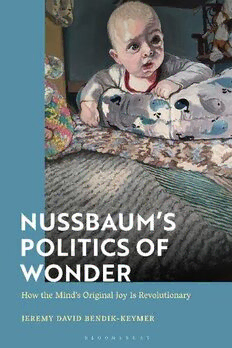
Nussbaum’s Politics of Wonder: How the Mind’s Original Joy Is Revolutionary PDF
241 Pages·2023·49.641 MB·English
Most books are stored in the elastic cloud where traffic is expensive. For this reason, we have a limit on daily download.
Preview Nussbaum’s Politics of Wonder: How the Mind’s Original Joy Is Revolutionary
Description:
In an unconventionally written book that challenges the literary imagination of its readers, Jeremy Bendik-Keymer explores how wonder is central to Martha C. Nussbaum’s normative project. Nussbaum’s work is opposed to the emotional and political conditions of ‘narcissism’ – the tendency to seek to control the wills of others in order to defend oneself against perceived vulnerabilities. Our capacity for wondering is important for growing beyond narcissism.Bendik-Keymer elaborates a politics of wonder that is consistent with understanding this idea. Taking issue with understandings of wonder viewing it as an emotion of surprise or delight, he develops an alternate tradition finding wonder in concert with the freedom of imagination found by degrees within much of human understanding. The result is a constructive rereading of Nussbaum’s oeuvre, surprising for how it disencumbers her work of some falsehoods surrounding anxiety and anger and for the ways it implies an egalitarian politics of relational autonomy more socialist than liberal.Misty Morrison’s visual inquiry accompanies the book creating space for the reader to wonder. Morrison paints and prints how families involve wonder, starting with moments in her child’s life when she wonders what they might see. Nussbaum’s Politics of Wonder is an important contribution to the philosophy of wonder and is crucial for understanding the work of a leading philosopher.In an unconventionally written book that challenges the literary imagination of its readers, Jeremy Bendik-Keymer explores how wonder is central to Nussbaum’s normative project on the whole. Nussbaum’s work is opposed to the emotional and political conditions of ‘narcissism’ – the tendency to seek to control the wills of others in order to defend oneself against perceived vulnerabilities. Our capacity for wondering is important for growing beyond narcissism.Bendik-Keymer elaborates a politics of wonder that is consistent with understanding this idea. Taking issue with understandings of wonder viewing it as an emotion of surprise or delight, he develops an alternate tradition finding wonder in concert with the freedom of imagination found by degrees within much of human understanding. The result is a constructive rereading of Nussbaum’s oeuvre, surprising for how it disencumbers her work of some falsehoods surrounding anxiety and anger and for the ways it implies an egalitarian politics of relational autonomy more socialist than liberal.Misty Morrison’s visual inquiry accompanies the book creating space for the reader to wonder. Morrison paints and prints how families involve wonder, starting with moments in her child’s life when she wonders what he might see.
See more
The list of books you might like
Most books are stored in the elastic cloud where traffic is expensive. For this reason, we have a limit on daily download.
